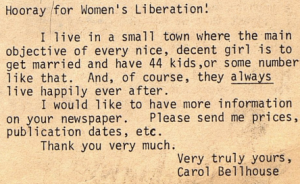
Carol Bellhouse, a rural woman, wrote into Off Our Backs: A Women’s Liberation Newspaper in January of 1971 with a letter entitled “Hooray for Women’s Liberation!”, expressing a keen interest in receiving more feminist periodical material.
Letters written to feminist publications from women in the country make incredibly clear their earnest interest in feminism both as a concept and in practice. Feminist periodicals, especially those like Country Women that are attuned to the specific oppressions and needs of rural women, play an essential role in disseminating feminist ideology in the countryside. They allow for women to connect with feminist ideas when people in their community may not be doing that work. They allow for rural women to express themselves in the form of art, poetry, and the circulation of how-to articles for other rural women looking to hone their crafts. One woman from a “small town” derides the traditional feminine lifestyle that she encounters around her, stating that the main objective of the “nice, decent girl[s] in her town is to get married and have 44 kids.” She writes to Off Our Backs, a newspaper of the Women’s Liberation Movement, requesting more materials from the newspaper (Bellhouse 5). This is just one example of a woman in the countryside that is hungry for feminist literature and to engage with the movement. Though it is just one woman, coupling this with the many women that write in and contribute to Country Women, the feminist presence in the countryside cannot and must not be discounted. The letter of a feminist collective in Alberta, Canada, to Country Women is another testament to this hunger, a representative stating that they all “leaped at the literature and ideas of the [feminist] movement, convinced that it was valuable to us” (Slim 4). Rural women were actively engaging with the feminist thought of the time, seeking out this material and often discussing it in groups. Feminist publications are especially “valuable” to country women, who may not have a women’s resource center or consciousness-raising group located in their area.

A letter from a women’s collective in Canada, published in the 8th issuing of Country Women in 1973, commenting on the profound importance that feminist literature and periodicals have for isolated rural women. A picture of a woman feeding her chickens appears alongside the letter.
Another woman writing to Country Women expresses not only a lack of feminist resources in her area but an outright lack of support for and acceptance of female farmers, expressing that she “had to draw support from women through publications” (Slim 4). It is easy to see how a publication like Country Women would be instrumental in the lives of many farming women looking to find a community within what could have been an, at times, hostile rural environment. These publications allow for rural women to feel supported and tapped into the national Second Wave feminist movement occurring at the time. Perhaps Country Women shouldered the burden of this job connecting rural women even more than other periodicals, with a reflection on their printing holding that “because many women who read Country Women see no other feminist publication, we discovered the important role we play in introducing the women’s movement to our more isolated sisters” (Bye 60). Even though these women are isolated and it is likely difficult for them to access feminist print material, issues like Country Women still circulated widely and truly did allow for some manifestation of connection to form among farming women across North America. Feminist periodicals are an avenue for connection among remote rural women and were critical in shaping the Second Wave feminist movement in the country.
Works Cited:
Bellhouse, Carol. “Hooray for Women’s Liberation!” Off Our Backs, vol. 1, no. 16, off our backs, inc., 21 Jan. 1971, p. 5.
Bye, Harriet. “Country Women in Print.” Country Women, no. 22, Country Women Editorial Collective, 01 Dec. 1976, pp. 60-61.
Slim. “Letters to Country Women.” Country Women, no. 8, Country Women Editorial Collective, 01 Oct. 1973, pp. 2-8.
